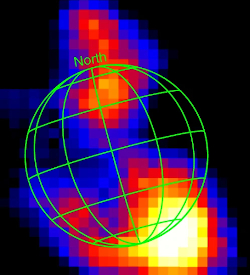The northern and southern lights, the
aurorae, are produced by charged particles (electrons, protons and other positively-charged atoms) trapped by the magnetic field of a planet. Spinning planets generate magnetic fields because of organized electric currents in their interior, producing a natural
electrical dynamo, which generates lines of magnetic force emanating from the "north" to the "south". On earth, aurorae are produced when charged particles from the Sun get trapped by the earth's magnetic field and spiral down near the poles. Other planets have magnetic fields and aurorae too. The planet with the largest magnetic field is
Jupiter, so you might expect beautiful auroral displays - and you wouldn't be disappointed. On Jupiter, the charged particles which produce aurorae come from Jupiter's moon Io, a small body close to Jupiter. Io is the
most volcanically active body in the solar system, because it's constantly pulled and pushed by Jupiter's strong gravity. Volcanic eruptions from Io spray hot molten rock and gas into space. Some of this electrically-charged gas is trapped by Jupiter's magnetic fields, and produce the Jovian aurorae. A new observation, shown above, by the
NuSTAR high energy X-ray satellite, has recently detected the highest energy emission seen from Jupiter's aurora (or from any other planet aside from earth, for that matter). In the image the circle labelled "NuSTAR PSF" represents the NuSTAR point-spread function, an approximation of the small structure NuSTAR can see on Jupiter. These NuSTAR observations help solve a decades-old mystery left behind by the
Juno spacecraft in orbit around Jupiter concerning how, exactly, the X-ray emission from the Jovian aurorae are produced. These NuSTAR observations suggest that similar auroral processes actually operate on Jupiter and earth - and maybe Saturn, too.
 HEAPOW: Jupiter's High Energy Light Show (2022 Mar 07)
HEAPOW: Jupiter's High Energy Light Show (2022 Mar 07)
